Arizona has some of the best bird-watching spots in the nation. While visiting, you may see hundreds of different bird species, including woodpeckers! Here we have a list of 12 woodpeckers in Arizona, what they look like, and where to find them!
1. Acorn Woodpecker
Starting our list is the acorn woodpecker. This bird species has a long range. They are found in the western United States and parts of Central America. Acorn woodpeckers are also very abundant. They are listed as Least Concern on the IUCN Red List. These lovely medium-sized woodpeckers are about 8.3 inches long. On average, they weigh approximately 3 ounces.
Acorn woodpeckers also have a very distinct look. They have brownish-black heads and a white forehead, throat, and rump. Although they mostly look similar, some acorn woodpecker subspecies have a bright red cap starting at the forehead. These lovely birds are excellent fliers and foragers. As their name suggests, they mainly consume acorns.
Acorn woodpeckers are common in Arizona. They are found throughout the state in oak groves. You can spot them in large groups.

Acorn woodpeckers are very common in Arizona.
©Ondrej Prosicky/Shutterstock.com
2. Hairy Woodpecker
The next woodpecker on our list is the hairy woodpecker. This species is listed as Least Concern on the IUCN Red List. They are about the same size as acorn woodpeckers, only slightly larger. Hairy woodpeckers are about 9.8 inches long. They also weigh between 1.4 to 3.4 ounces.
Hairy woodpeckers have black upperparts and wings. They also have thick white stripes or bars above and below their eyes. In this species, only males have red patches or bars.
Hairy woodpeckers are widely distributed in North America. You can find them from the Bahamas to Canada. They also live in Costa Rica and El Salvador. In Arizona, you can find these lovely birds in woodlands and forests. They are very common in the state.
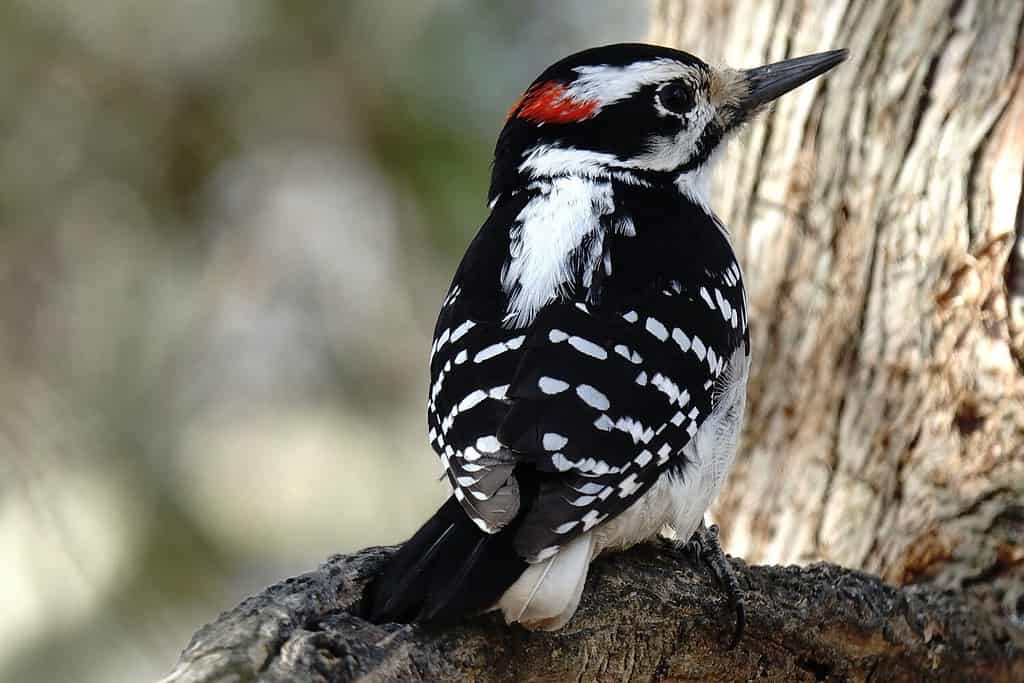
Male hairy woodpeckers have a bright red bar or two stripes on their heads. Females do not have this red marking.
©Carl Reader/Shutterstock.com
3. Downy Woodpecker
Next is the downy woodpecker. Downy woodpeckers are sometimes mistaken for hairy woodpeckers. They are native to North America. These small birds are also the smallest woodpecker species on the continent. There are seven recognized subspecies. Currently, on the IUCN Red List, downy woodpeckers are Least Concern.
Downy woodpeckers are mainly black and white. They are about 5.5 to 7.1 inches long with a wingspan of up to 12.2 inches. Generally, they weigh about an ounce or less. Downy woodpeckers have black feathers, with white throats and bellies. Their black wings also have white markings. Male downy woodpeckers also have a red patch on the back of their heads.
In Arizona, you can find these lovely birds in deciduous woods. They are common throughout the state and are sometimes found in large groups made up of other bird species.
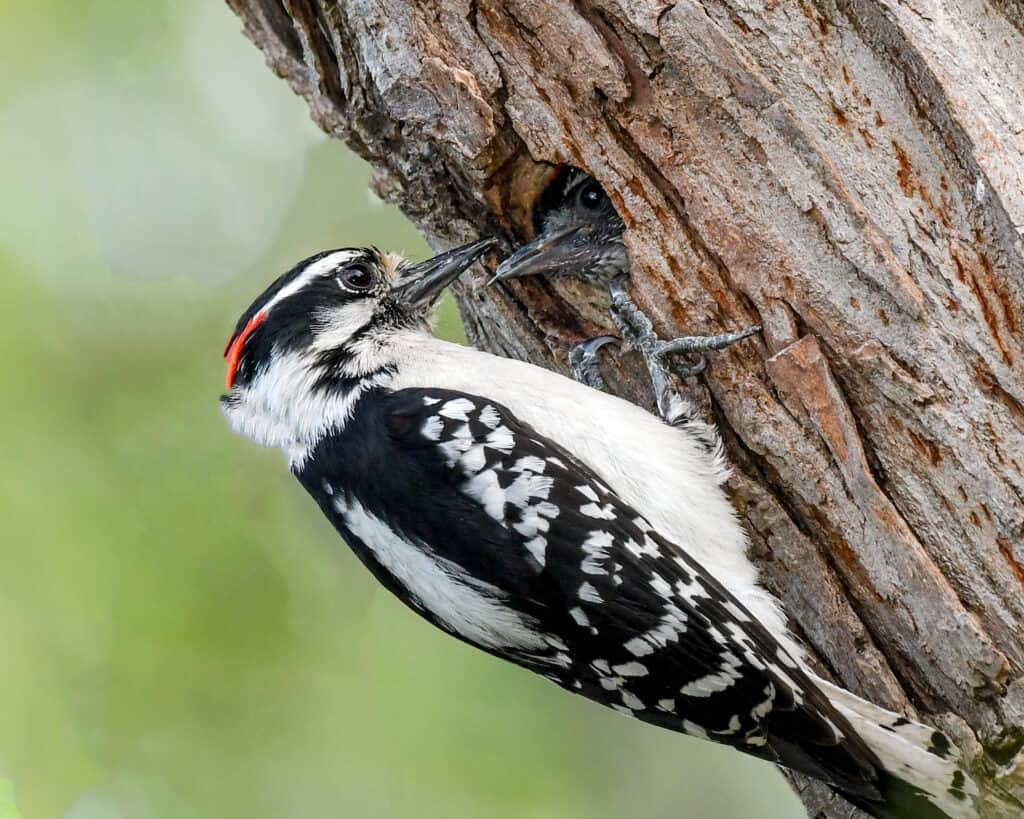
Downy woodpeckers are the smallest woodpecker species in North America.
©Brent Barnes/Shutterstock.com
4. Williamson’s Sapsucker
Another woodpecker on our list is the Williamson’s sapsucker. These medium-sized birds range in appearance. They are common in North Carolina. On the IUCN Red List, these sapsuckers are Least Concern. Williamson’s sapsuckers are named after Lieutenant Robert Stockton Williamson. These amazing woodpeckers live in open forests and are partially migratory. You can find them from British Columbia to Mexico.
Williamson’s sapsuckers are about 8 to 9 inches long. They weigh about 1.6 to 1.9 ounces. Male and female Williamson’s sapsuckers vary in coloration. For instance, males have iridescent black feathers on their heads, backs, tails, and sides. They also have a long white stripe from their eye and two others on the side of their heads. Males also have yellow bellies. Females, on the other hand, are mainly black with pale yellow breasts. They also have brownish heads.
Williamson’s sapsuckers aren’t as common as hairy or downy woodpeckers. Still, you can find them across the state as they migrate to their breeding grounds. During the winter, they visit Arizona’s mountains.
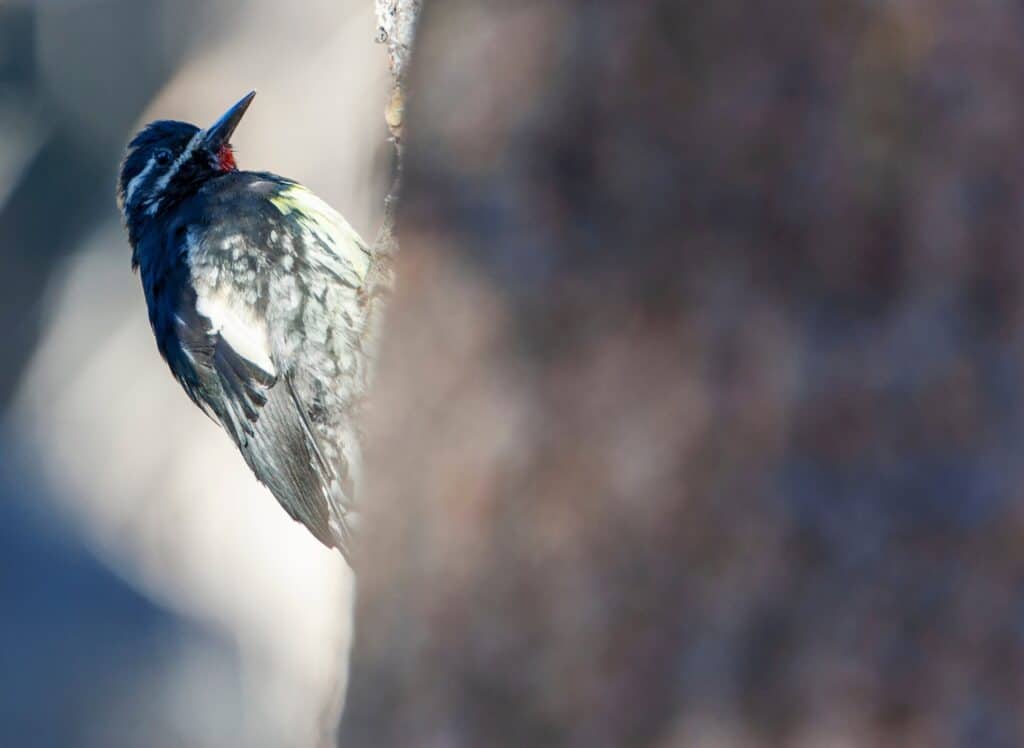
Williamson’s sapsuckers vary in appearance. Males and females look very different.
©Traveller MG/Shutterstock.com
5. American Three-toed Woodpecker
Next on our list of woodpeckers in Arizona is the American three-toed woodpecker.
They are medium woodpeckers native to North America. Like the previous woodpeckers on our list, they are listed as Least Concern on the IUCN Red List. American three-toed woodpeckers are about 8.3 inches long and on average weigh 1.9 ounces. These beautiful woodpeckers coniferous forests throughout North America. They have a unique range. You can find these lovely birds in Canada, parts of the northeastern United States, and some western states.
American three-toed woodpeckers have blackheads, wings, and rumps. Males though, have a yellow cap on their heads. They also have white bellies, throats, and markings on their tails.
In Arizona, American three-toed woodpeckers are a rare sight. They live in coniferous forests with decaying trees, which is where they hunt for beetle larvae. If you’re lucky and patient enough, you may see an American three-toed woodpecker in the Kaibab National Forest or the Grand Canyon National Park.

American three-toed woodpeckers mainly eat insects. Male American three-toed woodpeckers have a yellow cap on their heads.
©Jukka Jantunen/Shutterstock.com
6. Northern Flicker
Northern flickers are vibrant woodpeckers that also live in Arizona. They have a wide range. You can find them throughout North America, as well as Cuba, the Cayman Islands, and parts of Central America. They are listed as Least Concern on the IUCN Red List. Currently, there are ten recorded subspecies of northern flickers, one of which is extinct. However, experts still debate the actual number of subspecies.
Northern flickers are easy to identify compared to other North American woodpeckers. These lovely birds though range in color and markings depending on the subspecies. However, most northern flickers are brown with black bars on the back and wings. They may also have beige to white bellies with black or grey spot-like markings. These birds are about 11 to 14 inches long and weigh 3 to nearly 6 ounces. Male northern flickers have a black or red stripe at the base of the beak.
You can find northern flickers across Arizona. They are common in backyards. You may also see them along forest edges or in open woods feeding.

Northern flickers vary a lot depending on their subspecies.
©Fiona M. Donnelly/Shutterstock.com
7. Red-Naped Sapsucker
Red-naped sapsuckers are vibrant woodpeckers native to parts of North America, mainly near the Rocky Mountains and Great Basin areas of North America. These lovely birds have quite a sweet tooth. They drill holes in sweet trees looking for nectar and insects.
Red-naped sapsuckers are about 7.5 to 8.3 inches long. They also weigh up to 2.3 ounces. These lovely birds have black heads with red foreheads and white stripes. They also have a small red spot on the nape.
In Arizona, you can see these birds during summer. They also live in New Mexico and Colorado. You can find red-naped sapsuckers in the mountainous areas of Arizona.

Red-naped sapsuckers are vibrant black, red, white, and yellow woodpeckers that search for nectar.
©Feng Yu/Shutterstock.com
8. Gila Woodpecker
Next on our list of woodpeckers in Arizona is the Gila woodpecker. Gila woodpeckers are beautiful medium woodpeckers that live throughout the desert regions of the southwestern United States and western Mexico. Apart from Arizona, you can also find these lovely birds in Nevada, New Mexico, and California. Gila woodpeckers have a large population. On the IUCN Red List, they are Least Concern.
Gila woodpeckers are black, white, and greyish-tan. Their wings have a black and white zebra-like pattern. Adult females and males are nearly identical, however, adult male Gila woodpeckers have a small red cap on the top of the head. These lovely birds are about 8 to 10 inches long. Gila woodpeckers are noisy birds and uniquely nest in saguaro cacti and mesquite trees.

Adult male Gila woodpeckers have a bright red cap on their head.
©iStock.com/G Parekh
9. Lewis’s Woodpecker
Have you ever heard of the Lewis’s woodpecker? It’s a dark, large North American woodpecker named after Meriwether Lewis. Like the other woodpeckers on our list, this species is listed as Least Concern on the IUCN Red List.
Lewis’s woodpeckers are hard to miss. They aren’t just large, but also very vibrant. They are about 10 to 11 inches long and weigh up to 5 ounces. Lewis’s woodpeckers have reddish-black breasts, a pinkish belly, a black rump, a gray collar, and a red face. Interestingly, while this bird is a woodpecker, they resemble crows because of their flapping during flight.
Not only are Lewis’s woodpeckers found in Arizona, but also in some Midwestern states. They’ve been spotted in Wisconsin and South Dakota, but aren’t common.
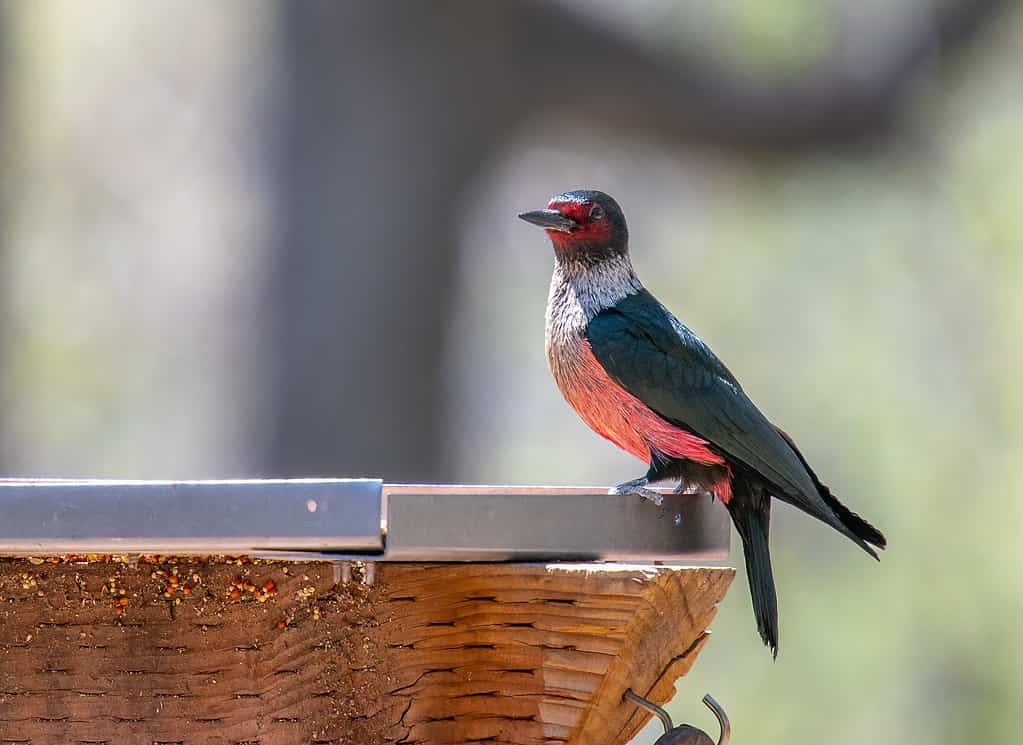
Lewis’s woodpeckers are named after Meriwether Lewis.
©Gerald DeBoer/iStock via Getty Images
10. Ladder-backed Woodpecker
You can also find the ladder-backed woodpecker in Arizona. The ladder-backed woodpecker is a small woodpecker, similar in appearance to both downy and hairy woodpeckers. They are mainly black, white, and red. Ladder-backed woodpeckers only reach about 7.5 inches, although many are only 6.5 inches long. As their name suggests, they have a ladder-like pattern on their back and wings.
The ladder-backed woodpecker also has a cream-colored rump and breast with specks of black. These birds also resemble Nuttall’s woodpeckers. Adult male ladder-backed woodpeckers have a distinct red crown patch. Female ladder-backed woodpeckers don’t have this red crown.
Ladder-backed woodpeckers are found in parts of Central and Southern Arizona. These desert-loving woodpeckers live in mesquite scrub and dry woodlands. Although uncommon, they sometimes visit bird feeders.
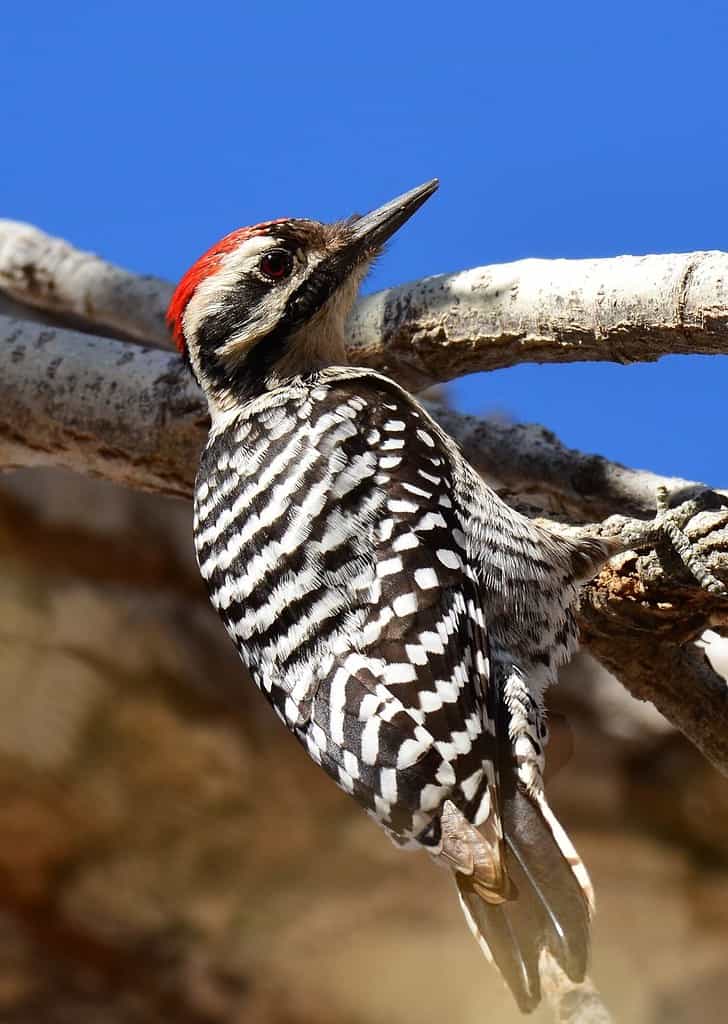
Ladder-backed woodpeckers are about 6.5 to 7.5 inches long.
©Nina B/Shutterstock.com
11. Red-Headed Woodpecker
Another lovely woodpecker in Arizona is the red-headed woodpecker. They are medium-sized woodpeckers with bright red heads, black and white wings, and white breasts. Red-headed woodpeckers have a wide range in North America. They are listed as Least Concern on the IUCN Red List.
Red-headed woodpeckers are about 7.5 to 9.8 inches long. Male and female red-headed woodpeckers have few to no differences. On average, these woodpeckers weigh about 2.4 ounces.
Although you can find red-headed woodpeckers in this dry and warm mountainous state, it’s very rare and considered accidental. Sometimes bird watchers spot them in Coconino and Santa Cruz.
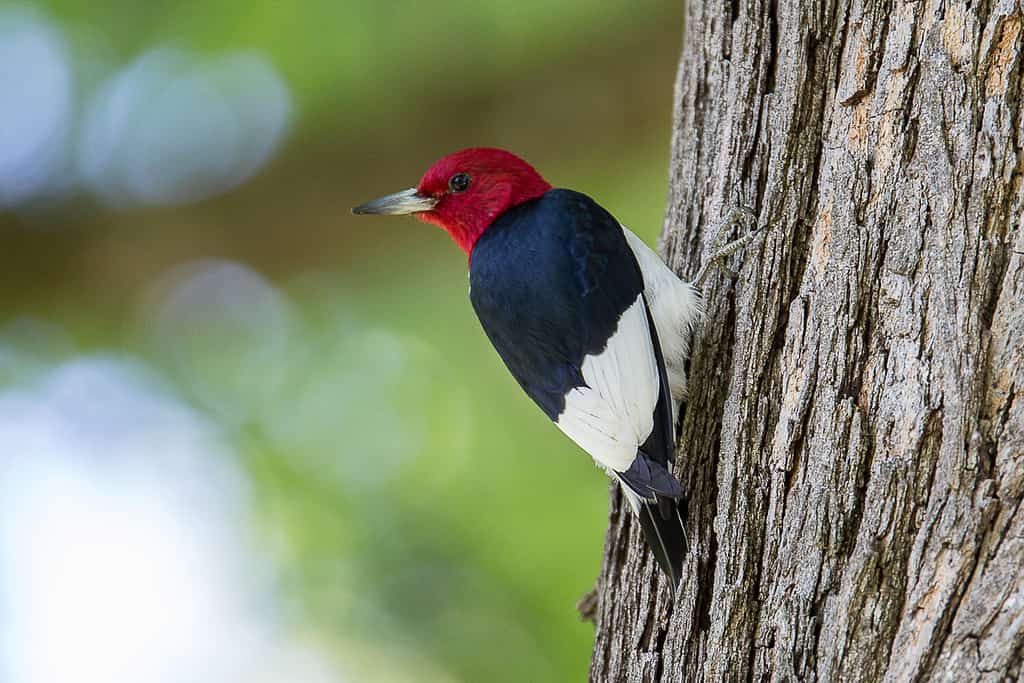
Red-headed woodpeckers are uncommon in Arizona.
©Benjamin King/Shutterstock.com
12. Gilded Flicker
The last woodpecker on our list is the gilded flicker. Gilded flickers are native to the Sonoran, Yuma, and eastern Colorado Desert regions of the southwestern United States and northwestern Mexico. They are abundant, with a compact range, and are listed as Least Concern on the IUCN Red List.
Gilded flickers have yellow underwings and vary in size and coloration depending on the subspecies. There are about four gilded flicker subspecies. In Arizona, you can find the Mearns’ gilded flicker.

There are four recognized gilded flicker subspecies.
©G Parekh/iStock via Getty Images
The photo featured at the top of this post is © Northernguy/Shutterstock.com
Thank you for reading! Have some feedback for us? Contact the AZ Animals editorial team.







